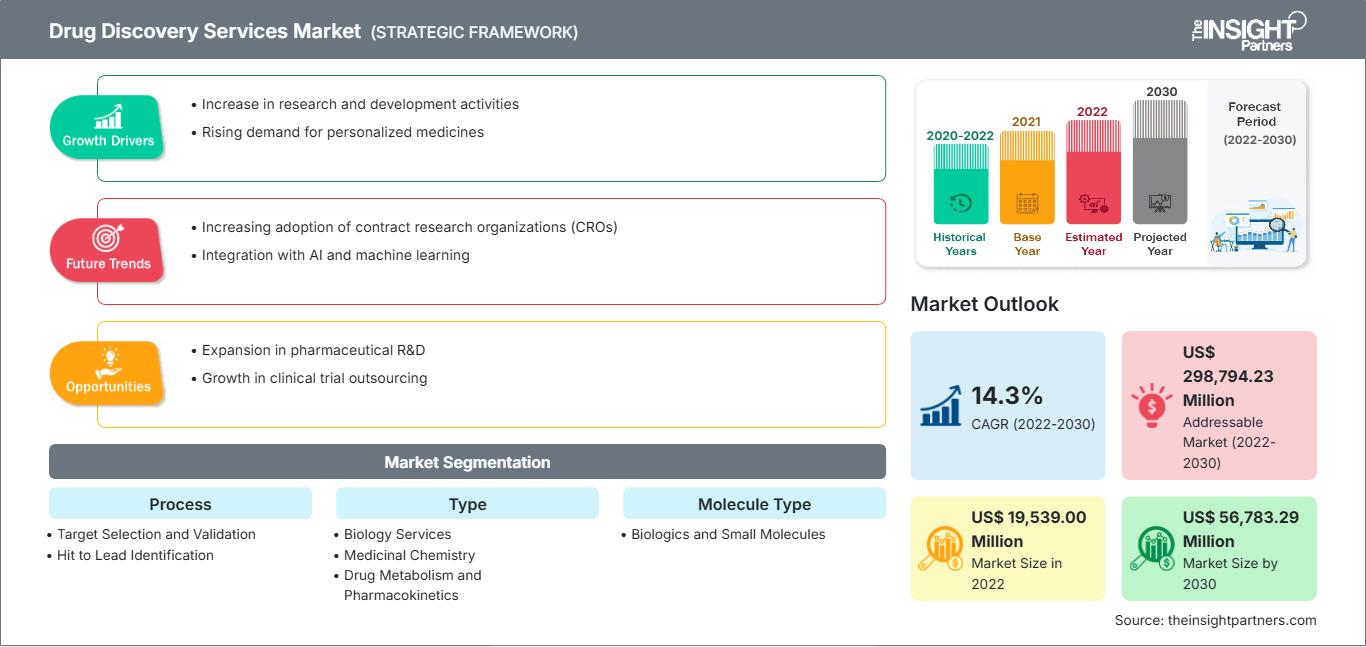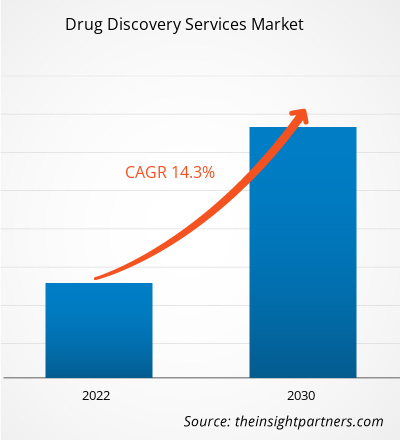[Forschungsbericht] Der Markt für Dienstleistungen im Bereich der Arzneimittelforschung soll von 19.539,00 Millionen US-Dollar im Jahr 2022 auf 56.783,29 Millionen US-Dollar im Jahr 2030 wachsen; für den Markt wird von 2022 bis 2030 eine durchschnittliche jährliche Wachstumsrate (CAGR) von 14,3 % erwartet.
Markteinblicke und Analystenmeinung:
Die Arzneimittelforschung ist der Prozess der Identifizierung oder Entwicklung neuer Medikamente zur Behandlung von Krankheiten und zur Verbesserung der menschlichen Gesundheit. Sie umfasst die Identifizierung potenzieller Arzneimittelkandidaten in verschiedenen Phasen, von der Synthese über Tests in Laboren und Tiermodellen bis hin zur Evaluierung in Studien am Menschen. Anbieter von Dienstleistungen im Bereich der Arzneimittelforschung bieten spezialisiertes Fachwissen und Ressourcen zur Unterstützung des Arzneimittelforschungsprozesses. Dazu können medizinische Chemie, computergestützte Modellierung, Hochdurchsatz-Screening und präklinische Testdienstleistungen gehören. Diese Dienstleistungen werden häufig von Auftragsforschungsinstituten (CROs) oder akademischen Forschungseinrichtungen erbracht. Pharmaunternehmen und Biotechnologiefirmen nutzen diese Dienstleistungen, um die Arzneimittelforschung zu beschleunigen, ohne ihre Effizienz zu beeinträchtigen.
Wachstumstreiber und Herausforderungen:
Der Markt für Dienstleistungen im Bereich der Arzneimittelforschung wächst aufgrund der ständig steigenden Nachfrage nach neuartigen Therapien in zahlreichen Therapiebereichen stark. Der Prozess der Arzneimittelforschung ist komplex und zeitaufwändig, und sein Erfolg basiert auf umfangreicher Forschung an potenziellen Arzneimittelkandidaten sowie deren Tests und Validierung. Daher verlassen sich Pharmaunternehmen und Forschungseinrichtungen zunehmend auf Dienstleister im Bereich der Arzneimittelforschung, die sie bei der Arzneimittelentwicklung unterstützen. Diese Dienstleister bieten unter anderem Zielidentifizierung und -validierung, Leitstrukturoptimierung, präklinische Studien sowie pharmakokinetische und toxikologische Tests an. Biotechnologie- und Pharmaunternehmen versuchen, gezielte Behandlungen zu entwickeln, die auf die spezifischen genetischen und molekularen Merkmale einzelner Patienten eingehen und so zu einem stärker personalisierten Ansatz in der Gesundheitsversorgung führen. Dies und der zunehmende Fokus auf Präzisionsmedizin und personalisierte Therapien treiben die Nachfrage nach Dienstleistungen zur Arzneimittelforschung weiter an.
Steigende F&E-Investitionen von Pharmaunternehmen und die Verfügbarkeit fortschrittlicher Technologien wie Hochdurchsatz-Screening, computergestützte Modellierung und künstliche Intelligenz kommen dem Markt für Dienstleistungen zur Arzneimittelforschung zusätzlich zugute. Diese Technologien ermöglichen effizientere und effektivere Prozesse zur Arzneimittelforschung und führen so zu einer höheren Erfolgsquote bei der Markteinführung neuer Medikamente. Der Prozess der Entdeckung und Entwicklung neuer Medikamente ist teuer und erfordert oft erhebliche Investitionen in Forschung, Entwicklung und klinische Studien. Die durchschnittlichen Kosten für die Entwicklung neuer Medikamente unter den 20 weltweit führenden Biopharmazeutika, die in der Studie „Genetic Engineering & Biotechnology“ untersucht wurden, stiegen im vergangenen Jahr um 15 % (298 Millionen US-Dollar) auf fast 2,3 Milliarden US-Dollar.
Die hohe Ausfallrate von Medikamentenkandidaten in den späteren Phasen klinischer Studien erhöht die Gesamtkosten der Arzneimittelentwicklung zusätzlich. Daher suchen Pharma- und Biotechnologieunternehmen zunehmend nach kostengünstigen Dienstleistungen zur Arzneimittelforschung, was die Dienstleister dazu zwingt, wettbewerbsfähige Preise anzubieten und gleichzeitig hohe Qualitätsstandards einzuhalten. Die hohen Kosten von Arzneimittelmolekülen wirken sich auch auf die Erschwinglichkeit neuer Therapien für Patienten aus, insbesondere im Fall seltener Krankheiten oder therapeutischer Nischenbereiche. Dies stellt sowohl für Arzneimittelentwickler als auch für Gesundheitssysteme eine große Herausforderung dar, wenn es darum geht, den Zugang zu innovativen Behandlungen zu ermöglichen.
Passen Sie diesen Bericht Ihren Anforderungen an
Sie erhalten kostenlos Anpassungen an jedem Bericht, einschließlich Teilen dieses Berichts oder einer Analyse auf Länderebene, eines Excel-Datenpakets sowie tolle Angebote und Rabatte für Start-ups und Universitäten.
Markt für Arzneimittelforschungsdienste: Strategische Einblicke

-
Holen Sie sich die wichtigsten Markttrends aus diesem Bericht.Dieses KOSTENLOSE Beispiel umfasst Datenanalysen, die von Markttrends bis hin zu Schätzungen und Prognosen reichen.
Berichtssegmentierung und -umfang:
Der Markt für Arzneimittelforschungsdienste ist nach Verfahren, Typ, Molekültyp, Therapiegebiet und Endnutzer segmentiert. Basierend auf dem Verfahren ist der Markt in Zielauswahl und -validierung, Hit-to-Lead-Identifizierung und Sonstiges (Assay-Entwicklung, Screening usw.) segmentiert. Der Markt für Arzneimittelforschungsdienste ist nach Typ in Biologiedienste, Medizinalchemie, Arzneimittelstoffwechsel und Pharmakokinetik segmentiert. In Bezug auf den Molekültyp wird der Markt für Arzneimittelforschungsdienste in Biologika und kleine Moleküle klassifiziert. Auf der Grundlage der Therapiegebiete wird der Markt in Herz-Kreislauf-Erkrankungen, Onkologie, Neurologie, Diabetes, Atemwegserkrankungen und Sonstiges differenziert. Nach Endnutzer ist der Markt für Arzneimittelforschungsdienste in Pharma- und Biotechnologieunternehmen, akademische Institute und Sonstiges segmentiert. Geografisch ist der Markt für Dienstleistungen im Bereich der Arzneimittelforschung in Nordamerika (USA, Kanada und Mexiko), Europa (Großbritannien, Deutschland, Frankreich, Italien, Spanien und übriges Europa), Asien-Pazifik (China, Japan, Indien, Südkorea, Australien und übriger Asien-Pazifik-Raum), Naher Osten und Afrika (VAE, Saudi-Arabien, Südafrika und übriger Naher Osten und Afrika) sowie Süd- und Mittelamerika (Brasilien, Argentinien und übriges Süd- und Mittelamerika) unterteilt.
Segmentanalyse:
Das Segment der kleinen Moleküle hatte je nach Molekültyp einen größeren Umsatzanteil am Markt für Dienstleistungen im Bereich der Arzneimittelforschung. Das Marktwachstum für kleine Moleküle wird darauf zurückgeführt, dass sie einfach zu untersuchen, gut definiert und leicht zu charakterisieren sind.
Im Jahr 2022 hatte das Segment der medizinischen Chemie nach Typ den größten Anteil am Markt für Dienstleistungen im Bereich der Arzneimittelforschung. Die Medizinische Chemie wird in verschiedenen Bereichen der Arzneimittelforschung umfassend eingesetzt, von der Wirkstoffkandidatenbereitstellung bis hin zu präklinischen Studien.
Nach Therapiegebieten betrachtet, dominierte das Segment Onkologie den Markt für Arzneimittelforschungsdienste im Jahr 2022. Das Marktwachstum in diesem Segment ist auf die weltweit zunehmenden Bemühungen zur Entdeckung von Krebsmedikamenten zurückzuführen. Die Onkologie ist aufgrund der steigenden Zahl verschiedener Krebsarten in der Bevölkerung ein stetig wachsender Markt. Die Internationale Agentur für Krebsforschung schätzte im Jahr 2020 etwa 10 Millionen krebsbedingte Todesfälle und 19,3 Millionen neue Krebsfälle. Die weltweite Zahl neuer Krebsfälle wird von 2020 bis 2040 voraussichtlich um 47 % steigen. Infolgedessen werden bis 2040 weltweit fast 28,4 Millionen neue Krebsfälle prognostiziert.
Arzneimittelforschungsdienste
Regionale Einblicke in den Markt für ArzneimittelforschungsdiensteDie Analysten von The Insight Partners haben die regionalen Trends und Faktoren, die den Markt für Arzneimittelforschungsdienste im Prognosezeitraum beeinflussen, ausführlich erläutert. In diesem Abschnitt werden auch die Marktsegmente und die geografische Lage in Nordamerika, Europa, dem asiatisch-pazifischen Raum, dem Nahen Osten und Afrika sowie Süd- und Mittelamerika erörtert.
Umfang des Marktberichts zu Arzneimittelforschungsdiensten
| Berichtsattribut | Einzelheiten |
|---|---|
| Marktgröße in 2022 | US$ 19,539.00 Million |
| Marktgröße nach 2030 | US$ 56,783.29 Million |
| Globale CAGR (2022 - 2030) | 14.3% |
| Historische Daten | 2020-2022 |
| Prognosezeitraum | 2022-2030 |
| Abgedeckte Segmente |
By Prozess
|
| Abgedeckte Regionen und Länder |
Nordamerika
|
| Marktführer und wichtige Unternehmensprofile |
|
Dichte der Marktteilnehmer im Bereich Arzneimittelforschungsdienste: Verständnis ihrer Auswirkungen auf die Geschäftsdynamik
Der Markt für Arzneimittelforschungsdienste wächst rasant. Dies wird durch die steigende Nachfrage der Endverbraucher aufgrund veränderter Verbraucherpräferenzen, technologischer Fortschritte und eines stärkeren Bewusstseins für die Produktvorteile vorangetrieben. Mit der steigenden Nachfrage erweitern Unternehmen ihr Angebot, entwickeln Innovationen, um den Bedürfnissen der Verbraucher gerecht zu werden, und nutzen neue Trends, was das Marktwachstum weiter ankurbelt.

- Holen Sie sich die Markt für Arzneimittelforschungsdienste Übersicht der wichtigsten Akteure
Regionale Analyse:
Geografisch ist der Markt für Dienstleistungen im Bereich der Arzneimittelforschung hauptsächlich in Nordamerika, Europa, den asiatisch-pazifischen Raum, den Nahen Osten und Afrika sowie Süd- und Mittelamerika unterteilt. Nordamerika trägt am stärksten zum Wachstum des globalen Marktes bei. Das Marktwachstum in dieser Region ist auf Investitionen von Arzneimittelentwicklungsunternehmen, hohe Zuschüsse der US-Regierung, die starke Präsenz großer Arzneimittelentwicklungsunternehmen, eine gut ausgebaute Gesundheitsinfrastruktur und einen Anstieg der Fälle chronischer Krankheiten zurückzuführen.
Die „Cancer Facts & Figures 2022“ der American Cancer Society schätzten bis Ende 2022 etwa 1.918.030 neue Krebsfälle und 609.360 krebsbedingte Todesfälle in den USA. Angesichts der hohen Krebsrate in diesem Bereich werden die Forschungsaktivitäten zur Entwicklung innovativer Krebsmedikamente in den USA in den kommenden Jahren voraussichtlich florieren. CytoReason und Pfizer haben im September 2022 eine mehrjährige Kooperation unterzeichnet. Gemäß dieser Vereinbarung kann Pfizer die künstliche Intelligenztechnologie von CytoReason für die Entwicklung von Medikamenten nutzen. Der Einsatz von KI-Technologie in der Arzneimittelforschung durch große Unternehmen in den USA dürfte die Expansion des Marktes für Arzneimittelforschungsdienste vorantreiben.
Der asiatisch-pazifische Raum wird zwischen 2022 und 2030 voraussichtlich die höchste durchschnittliche jährliche Wachstumsrate (CAGR) im Markt für Arzneimittelforschungsdienste verzeichnen. Das Marktwachstum in dieser Region ist auf steigende Investitionen in Forschungs- und Entwicklungsaktivitäten in Ländern wie China, Indien, Japan und Südkorea zurückzuführen, die sich zu wichtigen Zentren für Pharma und Biotechnologie entwickeln. Darüber hinaus machen das Vorhandensein eines großen Pools qualifizierter Forscher und Wissenschaftler sowie die im Vergleich zu westlichen Ländern niedrigeren Betriebskosten den asiatisch-pazifischen Raum zu einem attraktiven Ziel für das Outsourcing von Arzneimittelforschungsdiensten. Die zunehmende Verbreitung chronischer Krankheiten und der Bedarf an innovativen Medikamenten zur Deckung ungedeckter medizinischer Bedürfnisse schaffen eine Nachfrage nach neuen Medikamenten und begünstigen so das Wachstum des Marktes für Arzneimittelforschungsdienste in der Region.
Wettbewerbslandschaft und wichtige Unternehmen:
Agilent Technologies Ubiquigent, Abbott Laboratories Inc., Advinus Therapeutics Albany Molecular Research Inc., Aurigene, Bayer AG, AstraZeneca PLC, Charles River Laboratories International, Covance und ChemBridge Corporation sind einige der führenden Akteure auf dem Markt für Arzneimittelforschungsdienste. Diese Unternehmen konzentrieren sich auf die Ausweitung ihres Dienstleistungsangebots, um der weltweit wachsenden Verbrauchernachfrage gerecht zu werden. Ihre globale Präsenz ermöglicht es ihnen, einen großen Kundenstamm zu bedienen und so ihren Marktanteil auszubauen.
- Historische Analyse (2 Jahre), Basisjahr, Prognose (7 Jahre) mit CAGR
- PEST- und SWOT-Analyse
- Marktgröße Wert/Volumen – Global, Regional, Land
- Branchen- und Wettbewerbslandschaft
- Excel-Datensatz
Aktuelle Berichte
Verwandte Berichte
Erfahrungsberichte
Grund zum Kauf
- Fundierte Entscheidungsfindung
- Marktdynamik verstehen
- Wettbewerbsanalyse
- Kundeneinblicke
- Marktprognosen
- Risikominimierung
- Strategische Planung
- Investitionsbegründung
- Identifizierung neuer Märkte
- Verbesserung von Marketingstrategien
- Steigerung der Betriebseffizienz
- Anpassung an regulatorische Trends






















 Kostenlose Probe anfordern für - Markt für Arzneimittelforschungsdienste
Kostenlose Probe anfordern für - Markt für Arzneimittelforschungsdienste